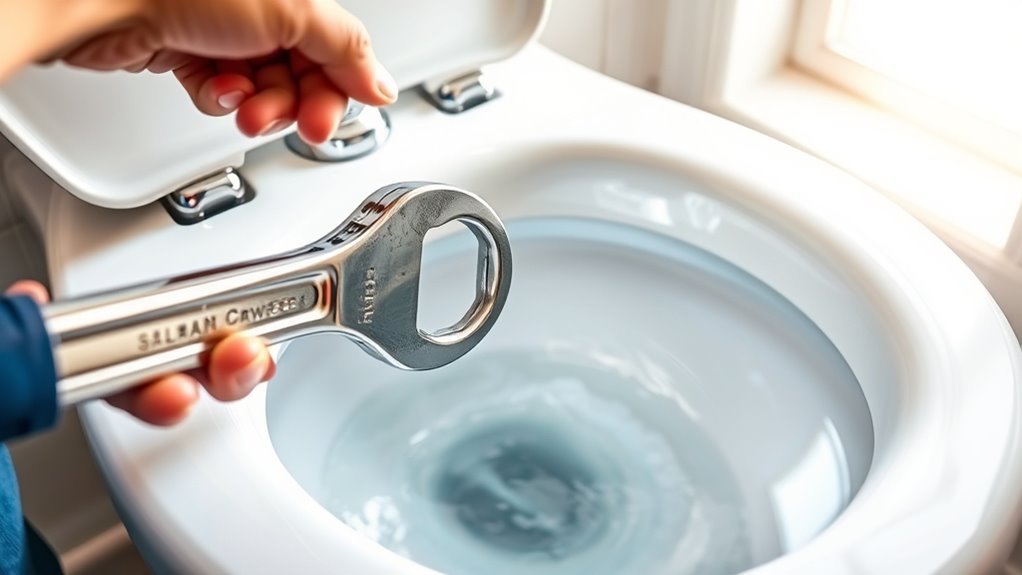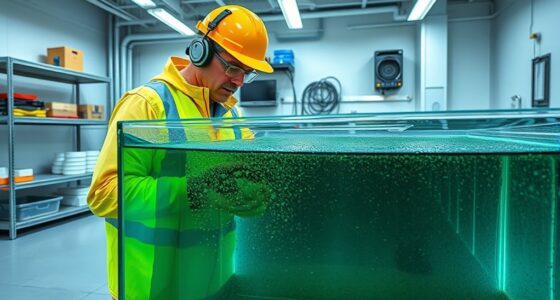Post-install flushing is essential to remove debris, rust, and residues, preventing future corrosion and ensuring water quality. You should perform the flush immediately after installation, using tools like hoses, wrenches, and safety gear. Run water until it’s clear, usually 5-10 minutes, and check for steady flow and no odors. Different systems may need tailored procedures. Keeping up with regular flushing helps maintain your plumbing’s lifespan—continue exploring to find out more.
Key Takeaways
- Post-install flushing removes debris, rust, and residues to prevent corrosion and ensure system longevity.
- Flushing should be done immediately after installation or repair for optimal results.
- Use proper tools and safety gear, including hoses, wrenches, gloves, and goggles, to ensure safe and effective flushing.
- Indicators of successful flushing include clear water flow, steady drainage, and absence of odors or gurgling sounds.
- Regular flushing and system checks help maintain plumbing efficiency, prevent buildup, and extend component lifespan.
Why Is Post-Install Flushing Important?

Why is post-install flushing so vital? It helps prevent corrosion by removing debris, rust, and mineral buildup that can compromise your plumbing system. Poor water quality after installation can lead to discoloration, odors, and reduced flow, affecting your daily use. Flushing ensures that any loose particles or contaminants are cleared out, protecting your pipes and fixtures. This process also promotes better water efficiency and extends the lifespan of your plumbing components. Skipping this step might invite corrosion, which weakens pipes over time and causes leaks. By thoroughly flushing after installation, you maintain ideal water quality and safeguard your system against potential damage. Additionally, water quality standards emphasize the importance of proper flushing to comply with health and safety regulations. In short, post-install flushing is a key step to keep your plumbing safe, clean, and functioning at its best.
When Should I Perform the Flushing Process?
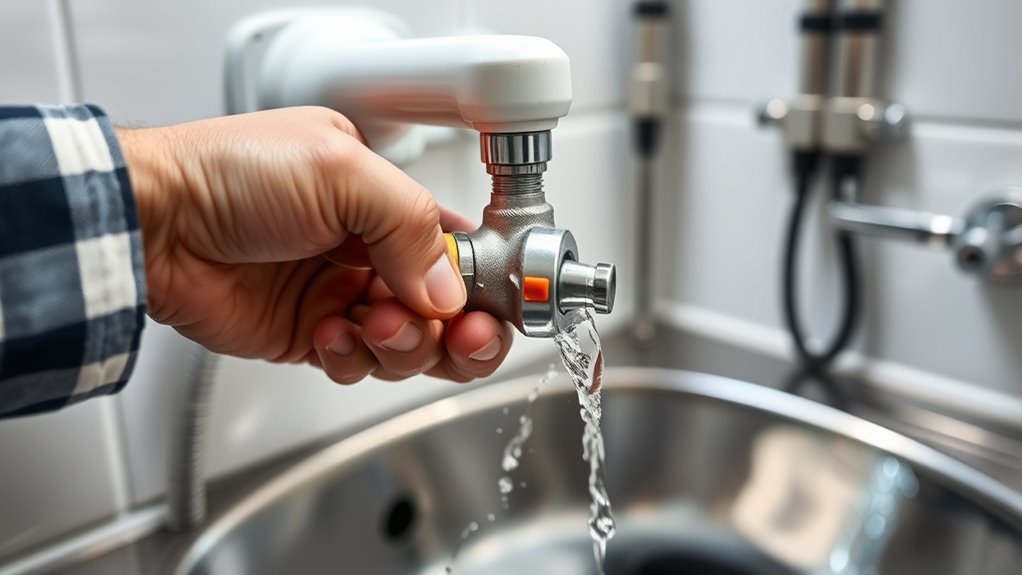
You should perform the flushing process immediately after completing the installation or repair of your plumbing system. Proper installation timing ensures that any debris, dirt, or residues from the project are cleared out before use. Delaying flushing can allow contaminants to settle or cause blockages, risking system performance. Planning your project scheduling to include flushing right after installation guarantees your system functions smoothly from the start. It’s best to schedule this step as the final part of your setup, so you don’t forget or rush it later. Performing the flush promptly also prevents corrosion or buildup from affecting your pipes and fixtures. Additionally, understanding celebrity transformations can inspire innovative ideas for updating your own space or style. In short, don’t wait—flush right after installation to maintain excellent system health and avoid future issues.
What Tools and Materials Do I Need for Flushing?
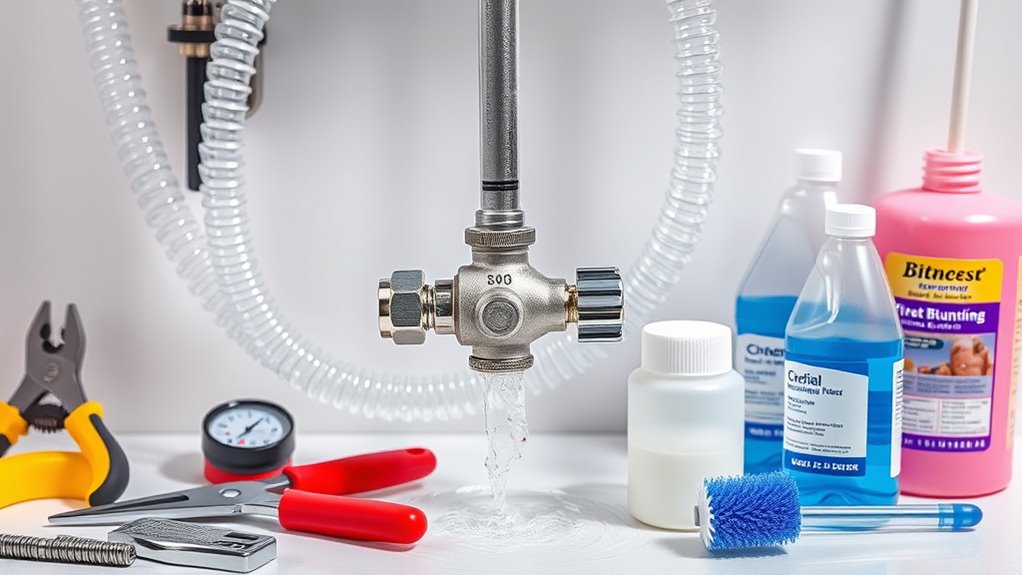
To get started, you’ll need essential tools like wrenches and hoses to connect and flush your system properly. Make sure you have the right cleaning materials, such as safe cleaning solutions and rags, to keep everything spotless. Don’t forget safety equipment like gloves and goggles to protect yourself during the process. Additionally, consider incorporating essential oils for cleaning to enhance the freshness and effectiveness of your flushing routine.
Essential Tools for Flushing
Flushing a system effectively requires having the right tools and materials on hand. You’ll need a wrench or adjustable pliers to disconnect pipes safely, and a hose for flushing water through the system. A pressure gauge is essential to monitor water pressure, preventing damage caused by excessive force. A bucket or container helps catch debris or excess water during the process. Additionally, a pipe brush or flexible cleaning tool can help remove buildup caused by pipe corrosion. Make certain you have access to a water supply with adjustable flow control, so you can regulate water pressure during flushing. Using proper safety precautions is crucial to avoid injury or damage during the process. These tools help you perform a thorough flush while minimizing potential damage, ensuring your system stays clean and functional after installation.
Necessary Cleaning Materials
When preparing to flush a system, gathering the right cleaning materials is vital for an effective and safe process. You’ll need appropriate cleaning agents designed for your specific system to break down debris and buildup. These might include specialized solutions or simple water-based cleaners. Additionally, have disposal methods in mind for the waste materials and used cleaning agents, guaranteeing they comply with local regulations. You may also require brushes, rags, or filters to help remove stubborn residues. Keep in mind that using the right cleaning agents prevents damage and guarantees thorough cleaning. Proper disposal methods are indispensable to avoid environmental harm or contamination. Collect these materials beforehand to streamline your flushing process and maintain safety and efficiency.
Safety Equipment Requirements
Having the right safety equipment on hand is essential for protecting yourself and ensuring the flushing process goes smoothly. You’ll need protective gloves and safety goggles to shield against splashes and debris. Proper gear minimizes risks and helps you work confidently. Before starting, gather the following essential safety equipment:
| Equipment | Purpose | Recommended Type |
|---|---|---|
| Protective gloves | Prevent skin contact with chemicals | Rubber or nitrile gloves |
| Safety goggles | Protect eyes from splashes | Impact-resistant goggles |
| Face mask | Avoid inhaling fumes | N95 or similar mask |
| Ear protection | Reduce noise from tools | Ear plugs or muffs |
| Work apron | Keep clothes clean | Waterproof apron |
In addition, understanding the importance of proper safety procedures can significantly reduce the risk of accidents during flushing.
How Do I Safely Flush a New Plumbing System?
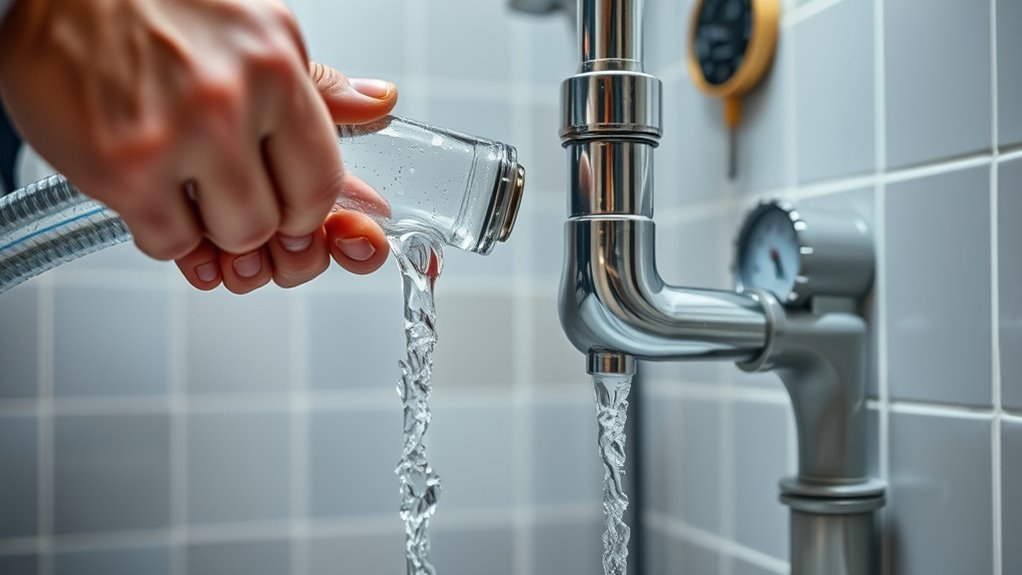
Before using your new plumbing system regularly, it’s essential to flush it thoroughly to remove any debris, dirt, or manufacturing residues. The pipe materials you have—whether PVC, copper, or PEX—may influence your flushing techniques. Start by opening all faucets and valves to allow water to flow freely. Use a moderate flow rate to push out contaminants without causing pressure issues. For pipes with tight bends or complex layouts, flush each section individually if possible. Be sure to check for leaks and ensure water flows smoothly from all outlets. This process helps clear any leftover debris and ensures your plumbing is clean and ready for everyday use. Proper flushing safeguards your system’s longevity and maintains water quality, especially considering modern fixtures that can improve water efficiency and performance.
How Long Should I Run the Water During Flushing?
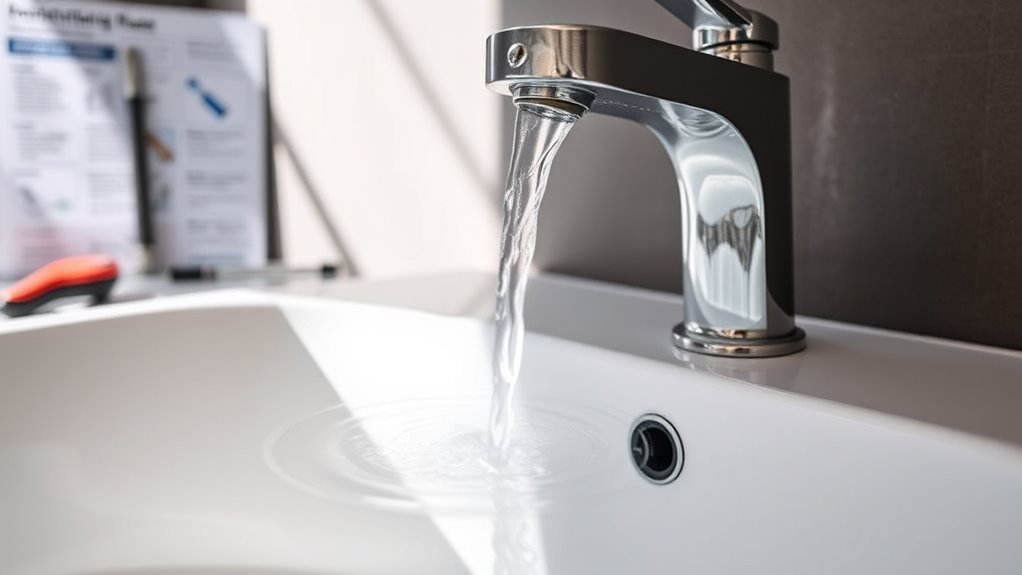
To effectively flush your plumbing system, run the water until it runs clear and any residual debris or discolored water is gone, which typically takes about 5 to 10 minutes. During this time, focus on maintaining a steady flow rate and a consistent water temperature. A higher flow rate helps clear debris faster, but avoid excessive pressure that could damage pipes. Using warm water at a moderate temperature can enhance flushing efficiency without risking damage from hot water. Keep the water running until you see clear, clean water. Monitor the process periodically to ensure debris is being flushed out properly. Regularly maintaining your plumbing can help prevent buildup and ensure optimal performance.
What Signs Indicate That Flushing Has Been Successful?

After flushing, you should notice a steady flow of water down the drain, with no slow or gurgling sounds. Additionally, there should be no lingering odors, indicating that the system is clean and clear. These signs confirm that your flushing was successful and your system is functioning properly. Incorporating predictive analytics can help monitor your plumbing system’s performance over time.
Steady Drain Flow
How can you tell if your drain flushing was successful? The most noticeable sign is a steady drain flow with consistent water pressure. Instead of sluggish or irregular draining, water should move smoothly without pauses or backups. Look for these indicators:
- Water flows quickly and steadily without hesitation
- No gurgling sounds or bubbling during drainage
- Water level in the sink or tub remains steady without rising
- Proper drain performance confirms that blockages have been effectively cleared
These signs confirm your drain is clear and functioning properly. A steady flow indicates the flushing removed blockages and restored normal water pressure. If you notice any irregularities, it might mean additional cleaning is needed. Keep an eye on how easily water drains to ensure your flushing efforts paid off.
Absence of Odors
When your drain flushing is successful, you’ll notice a marked absence of unpleasant odors. Odor elimination is a key sign that your pipes are clean and free of buildup or lingering debris. With effective flushing, foul smells no longer escape from your drains, improving your indoor air quality. You might also notice a fresher, cleaner scent in your space, indicating that the air isn’t being contaminated by trapped residues. The absence of odors confirms that your plumbing system is properly maintained and that no blockages or bacteria are causing unpleasant smells. Regular maintenance, such as filter replacement, can help ensure continued odor control and optimal performance. Overall, a successful flush results in better air quality and a more comfortable environment, giving you confidence that your drain system is functioning as it should.
Are There Different Flushing Procedures for Various Plumbing Systems?
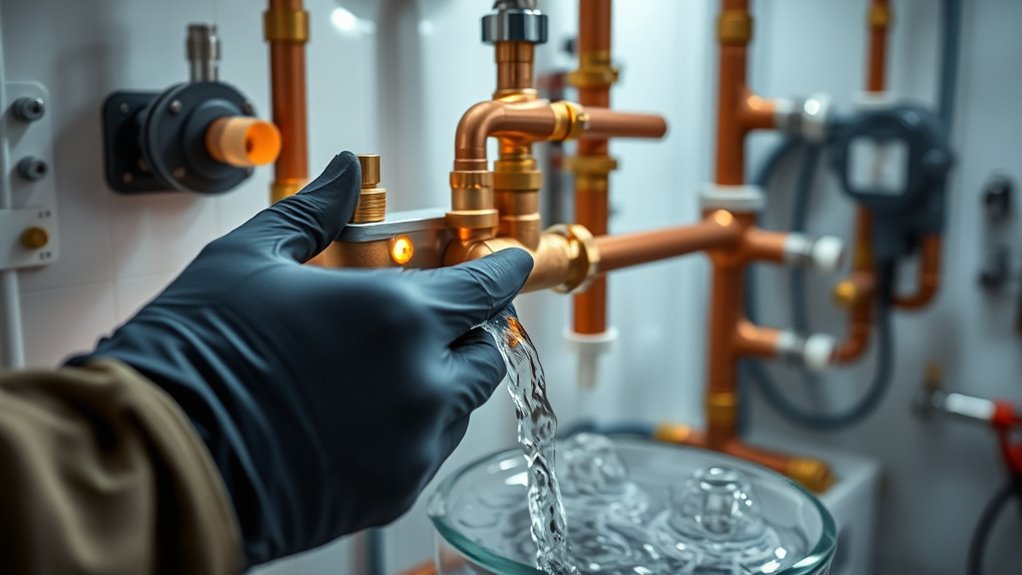
Different plumbing systems may require distinct flushing procedures to guarantee effective cleaning and prevent damage. Not all systems are the same, so understanding the right flushing techniques is essential. For example, your home’s typical drain system might need a simple water flush, while a commercial or industrial setup could require specialized methods. Knowing the types of plumbing involved helps you choose the correct approach.
Different plumbing systems require tailored flushing methods to ensure safety and effectiveness.
Consider these factors:
- The material of pipes (PVC, copper, cast iron)
- The complexity of the system layout
- The presence of sensitive components or fixtures
Using the wrong flushing techniques can lead to clogs or pipe damage. Always tailor your approach based on your specific plumbing type to ensure safe, effective cleaning.
How Often Should I Repeat the Flushing Process After Installation?
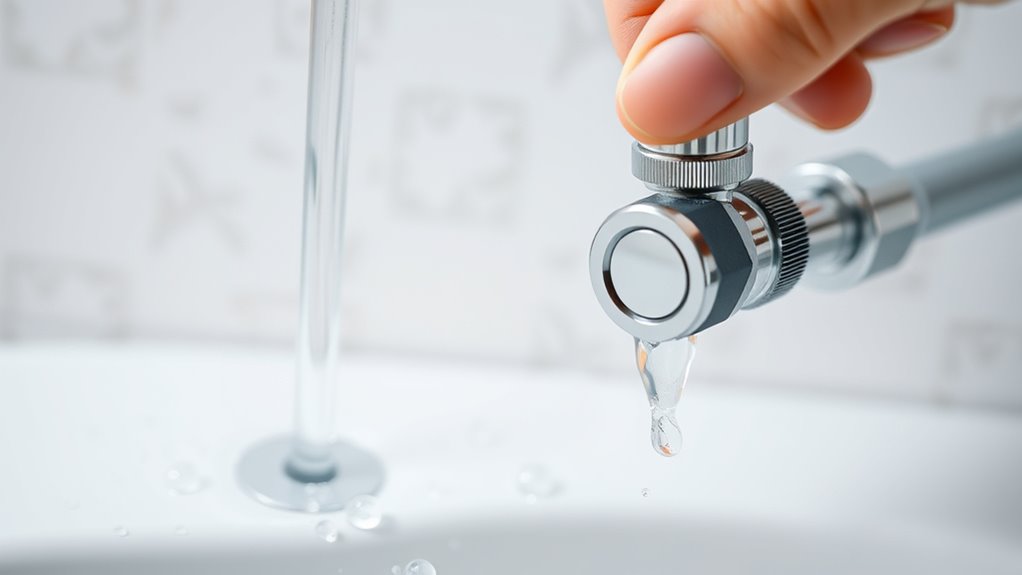
After completing the initial flush, it’s important to monitor your plumbing system to determine if and when you should repeat the process. Generally, you don’t need to flush repeatedly unless you notice issues like reduced water flow or lingering odors. If your system uses chlorine tablets for water disinfection, consider flushing every few months to replenish the disinfectant and prevent buildup. For water softening systems, periodic flushing helps remove mineral deposits and maintain efficiency, often every 6 to 12 months. Keep an eye on your water quality and system performance; if you detect any problems, a quick flush can help resolve them. Regular monitoring ensures your plumbing stays clean and functions smoothly, reducing the need for more extensive maintenance later.
Frequently Asked Questions
Can I Flush My Plumbing System Myself Without Professional Help?
Yes, you can flush your plumbing system yourself with some DIY tips and the right plumbing tools. Start by turning off the water supply, then remove and clean filters or aerators. Use a garden hose or flushing valve to clear out debris. Be cautious, and if you encounter complex issues or feel unsure, don’t hesitate to call a professional. Safety and proper technique are key to an effective DIY flush.
What Are the Common Mistakes to Avoid During Flushing?
You should avoid common mistakes like rushing the process or using improper techniques, which can lead to plumbing hazards. Don’t forget to turn off the main water supply first, and use the right tools to prevent damage. Skipping the safety steps or neglecting to check for leaks afterward can cause costly repairs later. Stay patient, follow instructions carefully, and you’ll guarantee a safe, effective flush without risking your plumbing system.
Is Chemical Flushing Safer Than Water Flushing?
Chemical flushing isn’t necessarily safer than water flushing; it depends on chemical safety and proper handling. Chemical flushing can be more effective at removing stubborn buildup, but it risks damaging your system if not used correctly. Water flushing is safer and more environmentally friendly, often providing better water efficiency. Always follow manufacturer instructions and safety guidelines to minimize risks and guarantee effective maintenance, regardless of which method you choose.
How Do I Dispose of the Waste Water After Flushing?
Think of waste water disposal as your chance to make a difference. You should collect the wastewater and take it to a local treatment facility or follow local regulations for safe disposal. Never pour it down drains or onto the ground, as it can harm the environment. Proper waste water disposal minimizes environmental impact and keeps your community safe. Always check with local authorities for specific disposal guidelines.
What Are the Signs That Flushing Needs to Be Redone?
You’ll know flushing needs to be redone if you notice clog indicators like slow drainage or frequent backups, or if you see pipe corrosion signs such as rust-colored stains or leaks. Persistent odors or reduced water flow also suggest the system isn’t functioning properly. Address these issues promptly to prevent further damage, and consider re-flushing to guarantee everything’s clean and operating smoothly.
Conclusion
Now that you understand the importance of proper post-install flushing, you’re equipped to guarantee your plumbing stays clean and efficient. While it might seem like a simple step, neglecting it can lead to clogs and damage down the road. Think of flushing as both a safeguard and a fresh start—like opening a window after a storm. Take the time now, and enjoy peace of mind later, knowing your system runs smoothly and reliably.
